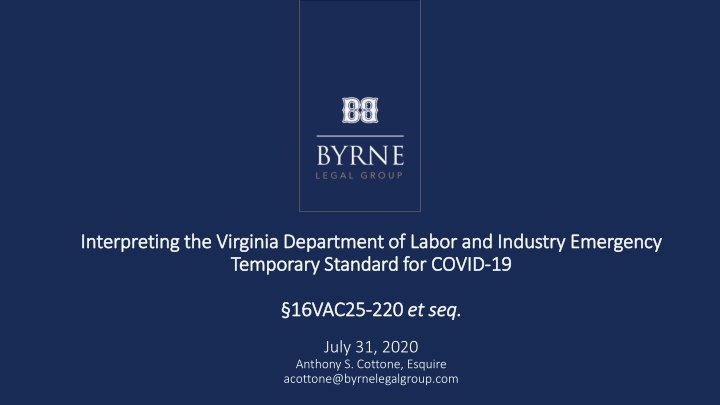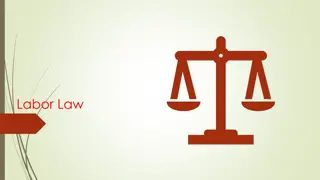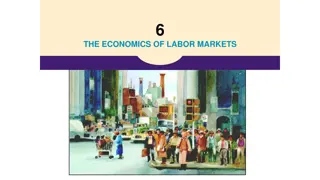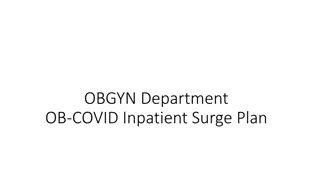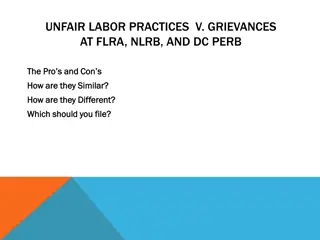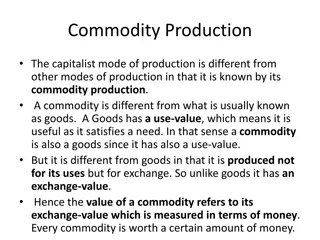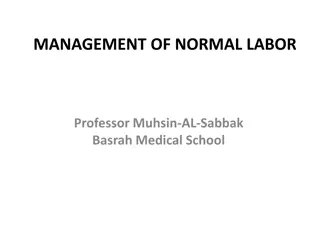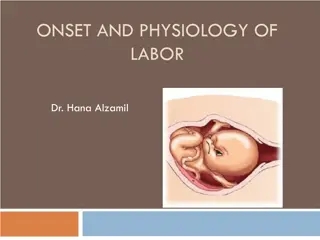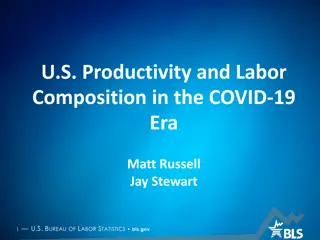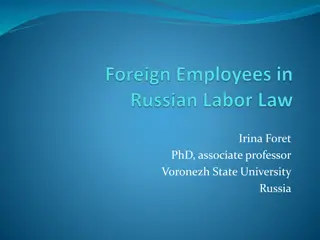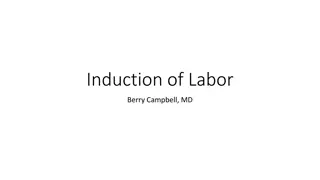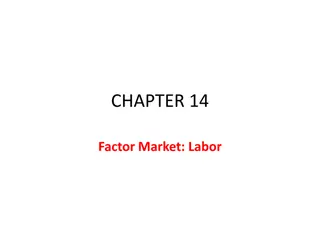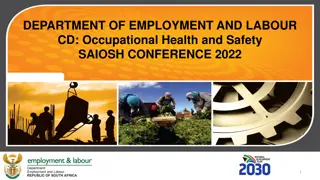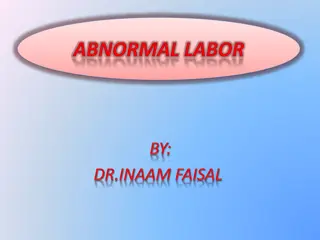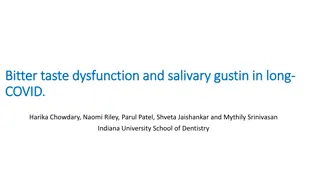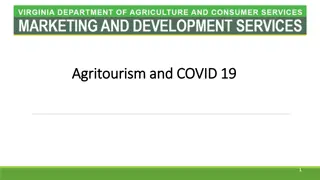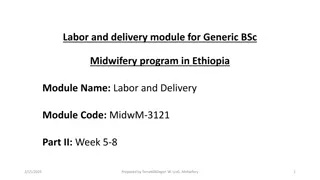Virginia Department of Labor: COVID-19 Safety Rules Overview
Virginia's Emergency Temporary Standard for COVID-19 aims to control, prevent, and mitigate the spread of the virus in workplaces. The standard sets out mandatory requirements for employers, including the development of an Infectious Disease Preparedness and Response Plan. It classifies employment settings based on risk levels and emphasizes compliance with CDC guidelines.
Uploaded on Feb 27, 2025 | 4 Views
Download Presentation

Please find below an Image/Link to download the presentation.
The content on the website is provided AS IS for your information and personal use only. It may not be sold, licensed, or shared on other websites without obtaining consent from the author.If you encounter any issues during the download, it is possible that the publisher has removed the file from their server.
You are allowed to download the files provided on this website for personal or commercial use, subject to the condition that they are used lawfully. All files are the property of their respective owners.
The content on the website is provided AS IS for your information and personal use only. It may not be sold, licensed, or shared on other websites without obtaining consent from the author.
E N D
Presentation Transcript
Interpreting the Virginia Department of Labor and Industry Emergency Interpreting the Virginia Department of Labor and Industry Emergency Temporary Standard for COVID Temporary Standard for COVID- -19 19 16VAC25 16VAC25- -220 220 et seq. et seq. July 31, 2020 Anthony S. Cottone, Esquire acottone@byrnelegalgroup.com
DISCLAIMER: This is provided for general information purposes only and is not intended to be legal advice. Please contact your attorney for additional information on this subject matter.
Road Map Overview of Virginia s Emergency Temporary Standard. Purpose of the Standard. Interpretations and Applications of the Standard. Employee Protections Timing for Implementation. Suggested Resources for Further Information.
Virginia the FIRST State to Adopt COVID Virginia the FIRST State to Adopt COVID- -19 Safety Rules 19 Safety Rules On July 17, 2020, the Virginia Department of Labor and Industry (VDLI) adopted the Emergency Temporary Standard Infectious Disease Prevention: SARS-CoV-2 Virus That Causes COVID-19 (The Standard). 16VAC25-220 et seq. The Standard applies to employers and employees falling under the jurisdiction of the Virginia Occupational Safety and Health (VOSH) Program. The Standard classifies employment settings based on their level of risk and sets forth mandatory requirements for employers. The Standard further requires the development of an Infectious Disease Preparedness and Response Plan.
Purpose of the Emergency Temporary Standard Infectious Purpose of the Emergency Temporary Standard Infectious Disease Prevention: SARS Disease Prevention: SARS- -CoV CoV- -2 Virus That Causes COVID 2 Virus That Causes COVID- -19 19 Establishes requirements for employers to control, prevent, and mitigate the spread of COVID-19. To supplement and enhance existing VOSH regulations. Actual compliance with CDC guidelines on COVID-19 will be considered good faith evidence of compliance. See https://www.cdc.gov/coronavirus/2019-nCoV/hcp/index.html. The Standard does not require employers to conduct contact tracing for COVID-19.
Key Definitions Key Definitions Suspected to be infected with SARS-CoV-2 virus Symptomatic for COVID-19 but has not tested positive. No alternative diagnosis has been made. Symptomatic includes Fever, chills, cough, shortness of breath, fatigue, body aches, headache, new loss of taste or smell, sore throat, congestion, nausea or vomiting, diarrhea. Symptoms appear 2-14 days after exposure. Known to be infected with the SARS-CoV-2 virus Symptomatic or asymptomatic patients who have tested positive for COVID-19. Employer knew or should have known the person tested positive for COVID-19.
First Things First Identify your Category of Exposure Risk First Things First Identify your Category of Exposure Risk Determine what Category Your Practice Falls Under Very High Risk High potential for employee exposure to people known to be infected or suspected to be infected. For example Practices or facilities treating COVID-19 patients. Practices or facilities performing procedures on COVID-19 patients. High Risk High potential for employee exposure inside of 6 feet of people known or suspected to be infected. For example Providing non-contact healthcare (physical or mental) and support services to COVID-19 (or suspected) patients. Skilled nursing, outpatient services, home health care, hospice, rehab, dental care, etc.
First Things First Identify your Category of Exposure Risk First Things First Identify your Category of Exposure Risk Determine what Category Your Practice Falls Under (Cont.) Medium Risk Tasks require more than minimal contact inside of six feet of anyone who is not known or suspected to be infected. For example Drug stores or pharmacies, correctional facilities, call centers, veterinary settings. Healthcare facilities not caring for known or suspected to be infected patients. Low Risk Tasks not otherwise considered very high , high , or medium exposure risk. Minimal occupational contact with other employees or general public. Able to achieve minimal contact through work practice controls. Floor to ceiling barriers, telework, staggered work shifts. Face coverings and social distancing still required.
Mandatory Requirements Regardless Of Exposure Risk Mandatory Requirements Regardless Of Exposure Risk Employers must assess their workplace for hazards that could expose employees to COVID-19. This may include categorizing different positions in your facility with different exposure risks. Encourage and inform employees on how how to self-monitor for signs and symptoms of COVID-19. Develop policies and procedures for employees to report known or suspected infection. Prohibit known or suspected infected employees from reporting to work until cleared (see below). Telework is allowed.
Mandatory Requirements Regardless Of Exposure Risk (Cont.) Mandatory Requirements Regardless Of Exposure Risk (Cont.) Ensure that sick leave policies are flexible and consistent with public health guidance. Pay close attention to Families First Coronavirus Response Act (FFCRA) regarding FMLA and Paid Sick Leave provisions. See US Department of Labor on the FFCRA Exceptions may exist for health care providers. Discuss policies with contract or temp employees. Establish a system to notify employees if another employee tests positive for COVID-19 within 24 hours of discovery of a potential exposure. Must remain HIPAA compliant. System must inform other employees who were present/near that employee, contractors, temp employees, and building/facility owner. Must inform the Virginia Department of Health within 24 hours. Must inform the Virginia Department of Labor and Industry within 24 hours of the discovery of 3 or more employees testing positive for COVID-19 within 14-day period.
Mandatory Requirements Regardless Of Exposure Risk (Cont.) Mandatory Requirements Regardless Of Exposure Risk (Cont.) Physical distancing required on the job and during breaks on property. Must use verbal announcements, signage, visual cues, etc. Restrict access to certain areas if needed. Access to common areas, breakrooms, etc. closed or controlled. If physical distancing cannot be accomplished due to nature of work, respiratory protection and PPE standards applicable to the industry apply. Does not require respiratory protection if contrary to medical condition. Sanitation and Disinfecting stations required. Areas where known or suspected infected people were present must be cleaned and disinfected. Frequent cleaning of shared spaces.
Mandatory Requirements for Returning to Work Mandatory Requirements for Returning to Work Employer must develop policies and procedures for known or suspected infected employees to return. Can be symptom-based or test-based. Symptom-Based = 3 days passed since recovery of symptoms. Test-Based = resolution of symptoms and negative COVID-19 test. Employer must develop policies for known infected but asymptomatic employees to return. Can be time-based or test-based. Time-Based = 10 days have passed since first positive test, without new symptoms. Test-Based = 2 consecutive negative tests over a period > 24 hours.
Mandatory Requirements for Mandatory Requirements for VERY HIGH or HIGH Risk Risk VERY HIGH or HIGH Exposure Exposure Must use air handling systems. Must install physical barriers. Hospitalized known or suspected infected patients must be placed in an airborne infection isolation room (AIIR). Must use AIIR rooms when performing procedures on known or suspected patients. Comply with US Dept. of Health and Human Services regulations when handling specimens of known or suspected infected patients. See Regulations.
Mandatory Requirements for Mandatory Requirements for VERY HIGH or HIGH Risk Risk VERY HIGH or HIGH Exposure Exposure Prescreening or surveying of employees before shifts. Limit non-employee access or restrict access to certain areas. Post signage requesting patients to immediately report symptoms of respiratory illness and to use face coverings. Offer enhanced medical monitoring of employees. Provide employees with education and training on prevention. Provide hand sanitizer at fixed work sites. Provide face coverings for known or suspected infected patients. Employees shall be provided with and wear gloves, gown, face shield/goggles, and respirator when in contact with known or suspected infected patients.
Mandatory Requirements for Mandatory Requirements for MEDIUM MEDIUM Exposure Risk Exposure Risk If air-handling systems are used, ensure they are appropriate and adequate. To the extent feasible, implement Prescreening and surveying; Provide face covering for suspected infected; Implement flexible worksites/work hours; Increase physical distancing between employees and others; Install physical barriers; and Require employers to provide and employees to wear face coverings when not physical distancing. Requirements for PPE ensembles in medium risk categories varies based on work task and exposures.
Infectious Disease Preparedness and Response Plan Infectious Disease Preparedness and Response Plan Who must have them and who does it apply to? Very high and high exposure risk facilities or employees. Medium exposure risk facilities with more than 11 employees. Applies to employees classified as very high , high , and medium exposure risks.
Infectious Disease Preparedness and Response Plan (Cont.) Infectious Disease Preparedness and Response Plan (Cont.) Developing the Plan Identify an administrator. Provide for employee involvement in development and implementation. Consider levels of exposure risk throughout facility. Consider contingency plans in response to outbreak. Identify basic prevention measures to implement. Provide for prompt identification and isolation of known or suspected infected people. Address infectious disease procedures with outside businesses such as contractors, etc. Suggestion: Document all of this and maintain in a readily accessible folder.
Training Employees on The Standard Training Employees on The Standard All employers with very high , high or medium exposure risk must train their employees on the hazards and characteristics of COVID-19. Training must include Mandatory requirements outlined above; Any CDC guidelines the employer follows; Methods of COVID-19 transmission; Signs and symptoms of COVID-19; Risk factors of severe COVID-19 illness with underlying conditions; Awareness of pre/asymptomatic transmission; Safe and healthy work practices; Use of PPE; Anti-discrimination provisions of the Standard (see below); and The Infectious Disease Preparedness and Response Plan.
Further Training Requirements Further Training Requirements All employers with very high or high exposure risk must verify compliance with training by preparing a written certification for their employees. Certification must include employee identity, employee signature, date of training, name of trainer, and name of person who prepared training. These certifications must be maintained for potential inspection. Employees may require retraining when there is reason to believe the employee does not understand the Standard s requirements.
Anti Anti- -Discrimination Clause Discrimination Clause Employees may not be discriminated against for exercising their rights under safety and health provisions in the Virginia Code and in implementing regulations under The Standard. Employees cannot be discriminated against for wearing their own PPE. Employees may not be discriminated against for raising reasonable concerns about infection control of the employer. Employees shall not be prohibited from refusing to do work or enter a location they feel is unsafe. See Virginia Whistleblower Statute
Timing for Implementation of The Standard Timing for Implementation of The Standard The Standard is NOW in effect as of JULY 27, 2020. TRAININGS MUST BE COMPLETED WITHIN 30 DAYS: AUGUST 26, 2020 IMPLEMENTATION AND TRAINING ON INFECTIOUS DISEASE PREPAREDNESS AND RESPONSE PLANS WITHIN 60 DAYS: SEPTEMBER 25, 2020. The Standard will expire within 6 months of its effective date, upon expiration of the Governor's State of Emergency, or when superseded by a permanent standard, whichever comes first.
HELPFUL RESOURCES HELPFUL RESOURCES The Virginia Department of Labor and Industry Virginia Occupational Safety and Health Administration Virginia Department of Health COVID-19 Guidance Center for Disease Control COVID-19 Guidance US Food and Drug Administration COVID-19 Information
Thank you! Any questions please contact Anthony S. Cottone, Esquire acottone@byrnelegalgroup.com (804) 804-4800 Office
